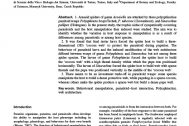Obsah
Araneid spiders of genus Araniella are attacked by three polysphinctine
parsitoid wasps Polysphincta boopsTschek, P. tuberose (Gravenhorst), and Sinarachna
pallipes (Holmgren). In the present study, the trophic niche of sympatrically occurring
parasitoids and the host manipulation they induced were studied. The aim was to
identify whether the variation in host response to manipulation is as a result of
differences among parasitoids or among host species.
It was found that final instar larva forced the spider host to build a threedimensional
(3D) ‘cocoon web’ to protect the parasitoid during pupation. The
behaviour of parasitoid larva and the induced modification of the web architecture
differed between wasps of genus Polysphincta and Sinarachna but not among three
spider species. The larvae of genus Polysphincta forced the spider host to build
the ‘cocoon web’ with a high thread density within which the pupa was positioned
horizontally. The larvae of Sinarachna forced the spider host to build web with sparse
threads and the pupa was positioned vertically in the middle of the ‘cocoon web’.
There seems to be an investment trade-off in parasitoid wasps: some species
manipulate the host to build a dense protective web, while pupating in a sparse cocoon,
whereas others make the spider produce a sparse web but build a dense pupa wall.



